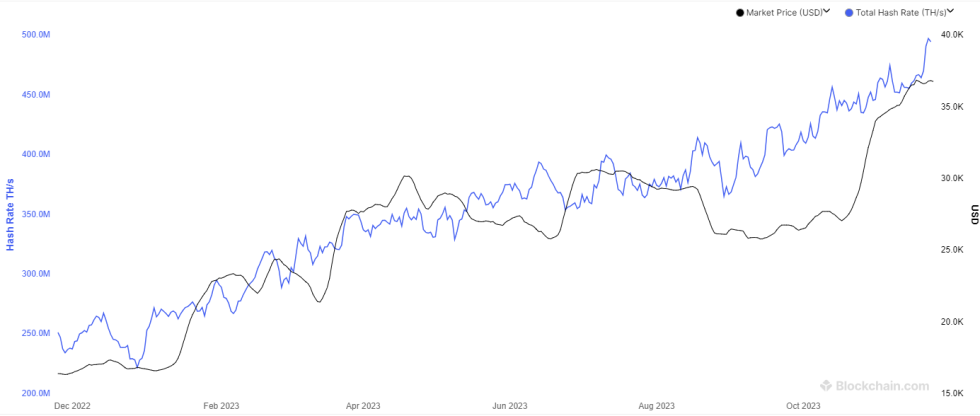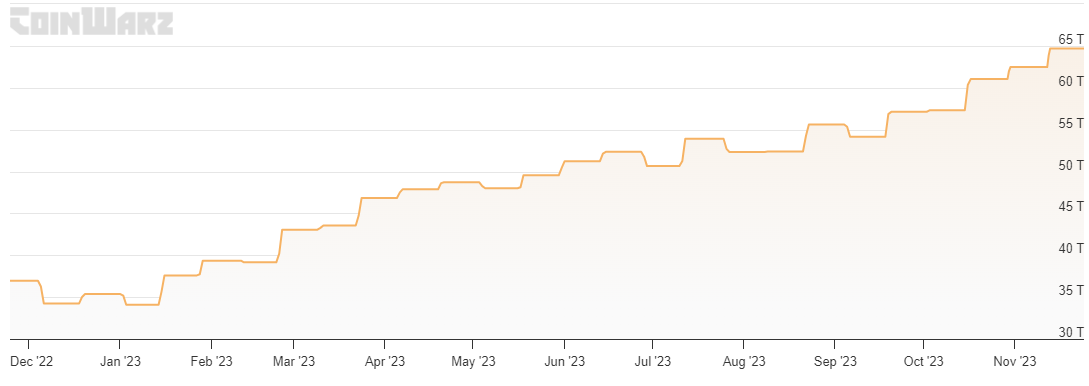On-chain data shows the Bitcoin mining difficulty is heading towards its sixth consecutive increase, which would be a new record for 2023.
Bitcoin Mining Difficulty Estimated To See Almost 4% Rise This Weekend
The Bitcoin “difficulty” refers to a feature on the blockchain that controls how hard the miners would find it to mine blocks right now. The metric’s value is measured in terms of the number of hashes that miners would need to generate before the next block can be found.
The network automatically adjusts its difficulty approximately every two weeks, and according to data from CoinWarz, the Bitcoin difficulty is set to see another such adjustment over the upcoming weekend.
Looks like the metric's value is about to go up | Source: CoinWarz
As you can see above, the Bitcoin mining difficulty is estimated to increase by over 3.8% in this coming adjustment, which would take its value to 67.14 trillion.
Now, the main question is: what’s the reason behind this difficulty increase? To understand this, you may first have to know why the difficulty feature exists on the network at all.
Whenever miners solve blocks, they get compensated in terms of BTC rewards. These BTC rewards are the only way to produce more of the cryptocurrency, so the rate at which these chain validators mine serves as the production rate for the asset.
Whenever the miners increase their total computing power (the hashrate), they naturally become faster at hashing blocks, thus claiming the BTC rewards.
Now, consider a scenario where the difficulty doesn’t exist. If miners continued to increase their computing power indefinitely, they could mow through blocks faster and faster. Eventually, the asset’s value would tank because of inflation as the market is flooded with new tokens.
Satoshi had foreseen the issue, and in an attempt to solve it, the anonymous creator had made it so that the miners would always mine at close to a network-standard rate of 1 block per 10 minutes. The feature that ensures that this is followed is indeed, the mining difficulty.
The above table shows that the average Bitcoin block time is 9.63 minutes currently, which is faster than the rate the blockchain intends to keep. This is the reason why the difficulty will go up in the next adjustment; miners will be slowed back down to the desired pace once they find it harder to find blocks.
The root cause of the recent faster block time lies in the explosive hashrate growth that the network has observed recently.

The 7-day hashrate has continued to rise | Source: Blockchain.com
Between the strong price growth and a spike in the transaction fees due to the Inscription hype returning and the network activity surging, miners have been having a great time in terms of their revenue.
So, it’s not surprising that the Bitcoin hashrate has recently seen such a rapid rise, as miners are doing everything to capitalize on the profitable opportunity.
As the metric has been setting new all-time highs for a while now, the difficulty has also been on its way up. The difficulty has seen five straight uplifts in the last five adjustments, matching the yearly record set in the year’s first half.

The value of the metric seems to have been going up since a while now | Source: CoinWarz
Thus, with another positive adjustment over the weekend, the Bitcoin mining difficulty will set another all-time high, breaking the 2023 record with a sixth consecutive rise.
BTC Price
Bitcoin is currently floating around the $37,800 mark as the asset gears up for another go at the $38,000 mark.
BTC is knocking on the door of $38,000 | Source: BTCUSD on TradingView
Featured image from Kanchanara on Unsplash.com, charts from TradingView.com, CoinWarz.com, Blockchain.com
Credit: Source link






















 Bitcoin
Bitcoin  Ethereum
Ethereum  XRP
XRP  Tether
Tether  Solana
Solana  USDC
USDC  Dogecoin
Dogecoin  Cardano
Cardano  Lido Staked Ether
Lido Staked Ether  TRON
TRON  Chainlink
Chainlink  Wrapped Bitcoin
Wrapped Bitcoin  Avalanche
Avalanche  Wrapped stETH
Wrapped stETH  Stellar
Stellar  Sui
Sui  Toncoin
Toncoin  Hedera
Hedera  Shiba Inu
Shiba Inu  WETH
WETH  LEO Token
LEO Token  Polkadot
Polkadot  Litecoin
Litecoin  Bitget Token
Bitget Token  Bitcoin Cash
Bitcoin Cash  Hyperliquid
Hyperliquid  USDS
USDS  Uniswap
Uniswap  Wrapped eETH
Wrapped eETH  Ethena USDe
Ethena USDe  Pepe
Pepe  MANTRA
MANTRA  NEAR Protocol
NEAR Protocol  Aave
Aave  Monero
Monero  Official Trump
Official Trump  Ondo
Ondo  WhiteBIT Coin
WhiteBIT Coin  Internet Computer
Internet Computer  Aptos
Aptos  Mantle
Mantle  Ethereum Classic
Ethereum Classic  Dai
Dai  Cronos
Cronos  POL (ex-MATIC)
POL (ex-MATIC)  Bittensor
Bittensor  OKB
OKB 
